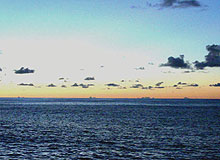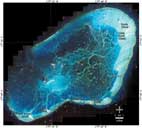NOWRAMP
2002
Where
Kane Hides the Islands
Posted by Scott Kikiloi, graduate researcher, Center for
Hawaiian Studies, U.H.M.
September 30, 2002
 Kanehunamoku
is one of twelve mythical islands under the control of Kane,
believed to lie somewhere off the main Hawaiian chain (Beckwith
1970). In certain popularized Hawaiian literature (Rice
1923; Westervelt 1915), these islands have been labeled
the "hidden islands" or "lost islands"
of the Hawaiian Archipelago. It is believed that these twelve
islands only appear during certain phases of the moon, specifically
on the night of Mohalu (the twelfth night of the
moon phase as it begins to round the first of the Kane
nights). They also make periodical appearances on the moon
phase of Akua (a full moon). The islands themselves
may lie under the sea or upon the surface, and can be seen
near the horizon when the sun is setting. These "hidden
islands" are also said to be capable of disappearing
into the clouds.
Kanehunamoku
is one of twelve mythical islands under the control of Kane,
believed to lie somewhere off the main Hawaiian chain (Beckwith
1970). In certain popularized Hawaiian literature (Rice
1923; Westervelt 1915), these islands have been labeled
the "hidden islands" or "lost islands"
of the Hawaiian Archipelago. It is believed that these twelve
islands only appear during certain phases of the moon, specifically
on the night of Mohalu (the twelfth night of the
moon phase as it begins to round the first of the Kane
nights). They also make periodical appearances on the moon
phase of Akua (a full moon). The islands themselves
may lie under the sea or upon the surface, and can be seen
near the horizon when the sun is setting. These "hidden
islands" are also said to be capable of disappearing
into the clouds.
While
romanticizing adds mystery and suspense to these mo`olelo,
it is important to understand what these traditions actually
represent in the natural world. Kanehunamoku and
the twelve sacred islands represent a concept that is tied
to real processes that have been observed for generations
by our ancestors. Over time the concept has become layered,
and embellished with color and flavor, but the meaning behind
it still holds true today. In Hawaiian thought, each akua,
or god manifests himself/herself in a number of elements
in the natural world ranging from coral types, marine life,
clouds, atmospheric strata, winds, mountains, plants, and
even natural processes. These manifestations are called
kinolau, or body forms. The god Kane has numerous
body forms, so many that I cannot list them all here. Kanehunamoku
is just one manifestation of this god, and it is a natural
phenomenon seen here in the Northwestern Hawaiian Islands.
 Most
of the islands in the Northwest region are very low atolls,
islets, seamounts, and shoals that are highly susceptible
to erosion from the ocean tides. A good example of this
is the atoll Pearl and Hermes. Pearl and Hermes was surveyed
in 1857 by the ship Manuokawai, as it reported seeing
six islets that make up the atoll. In 1859, the atoll was
surveyed again by the ship Gambia, who reported seeing twelve
small islands. Today there are only five islets that make
up Pearl and Hermes. These islets undoubtedly shift, disappear
over time, only to reappear later. Another example is Mokupapapa,
and flat-reef island that was recorded to exist by Captain
Cook on his expedition to these island, but has never been
verified to exist since. Oral traditions tell us that its
location is right next to Ka`ula island, however
there is nothing present there today.
Most
of the islands in the Northwest region are very low atolls,
islets, seamounts, and shoals that are highly susceptible
to erosion from the ocean tides. A good example of this
is the atoll Pearl and Hermes. Pearl and Hermes was surveyed
in 1857 by the ship Manuokawai, as it reported seeing
six islets that make up the atoll. In 1859, the atoll was
surveyed again by the ship Gambia, who reported seeing twelve
small islands. Today there are only five islets that make
up Pearl and Hermes. These islets undoubtedly shift, disappear
over time, only to reappear later. Another example is Mokupapapa,
and flat-reef island that was recorded to exist by Captain
Cook on his expedition to these island, but has never been
verified to exist since. Oral traditions tell us that its
location is right next to Ka`ula island, however
there is nothing present there today.
Kanehunamoku
is a phenomenon that captures this. What this process directly
translates to is the relationship between tidal changes
and moon phases, and the disappearance and reappearance
of low lying landforms. As the moon reaches different phases
with the Earth, it changes the gravitational pull of the
planet, and thus creates changes in currents, and the level
of our oceans. Islands that are sensitive to these changes
can disappear, and become "hidden" by the god
Kane. These traditions and ancient stories of Hawai`i
have many levels of meaning to them. They teach us important
lessons in life, based on thousands of years of observation
and learning. It is important to maintain the integrity
of these stories, so that these fundamental lessons don't
get "hidden" or "lost" themselves.
<<Journals
Home
 Talk About It!
Talk About It!
Kupuna Article
Asked by Kau'i from personal on Jan 17, 2007.
Aloha kaua,
Mahalo for the article and for providing wonderful insight into the customs, traditions, and mo'olelo of our kupuna that can be supported by today's scientists.
Answered by Paulo from University of Hawaii on Jan 17, 2007.
Dear Kau`i,
Thank you for your comment. We are glad that you enjoyed the article.
Sincerely,
Paulo